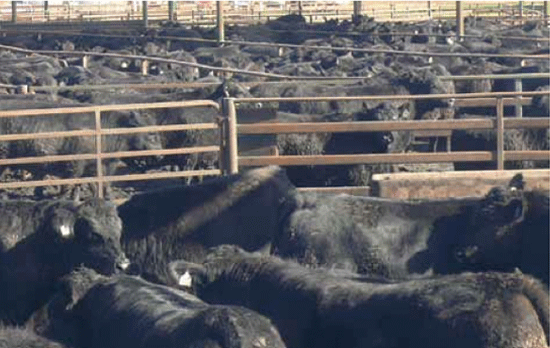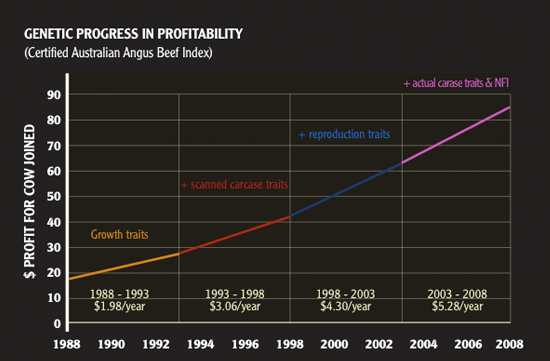



Boosting BreedPlan
Three funding terms of Beef CRC have ensured that new, hard-to-measure but economically very important traits have been added to BREEDPLAN, significantly increasing BREEDPLAN’s value to the beef industry. Prediction equations based on DNA information from the new high density panels will be delivered to BREEDPLAN by April 2012.Since the Beef CRC began contributing data to BREEDPLAN in 1993, performance-recorded Australian cattle breeds have shown steadily rising rates of genetic gain.
Now a wave of new genetic information is coming through, made possible by the inclusion of new DNA-based genomic technologies.
BREEDPLAN is built on “phenotypic” data, which comprises measured records of economically important characteristics of an animal. About a decade ago, technologies began appearing that seemed to promise to greatly reduce the enormous labour and cost of phenotypic recording by identifying the genes associated with these economically important traits.
At the time, “genotypic” (DNA-based) data promised a revolution that would leave the old methods in the dust. However, according to one of BREEDPLAN’s founders, Dr Hans Graser, Director of the Animal Genetics and Breeding Unit (AGBU), the process has proved not to be so simple. There is now a clear realisation that gene interactions are far more complicated than was originally thought.
Forecasts of dramatic advances through genomics were made on the assumption that a handful of genes would explain most of the genetic variation for a trait.
However once the Bovine Genome was sequenced in 2006 and the full assembly released in 2009, it became clear that things were not as straightforward as expected.
It turns out,Dr Graser says, that hundreds, even thousands of interacting genes may be at work to control a single trait.
Technology has produced some answers to this complexity, including the single-nucleotide polymorphism (SNP, pronounced “snip”) chip. These chips allow tens or hundreds of thousands of genetic sequence differences to be quickly compared against each other, revolutionising the business of gene discovery.
The Beef CRC has used this technology to record genetic differences from thousands of animals, even reaching back into its archival material to genotype long-dead cattle used in Beef CRC’s first term. A few CRC animals have also been fully sequenced, a procedure that was prohibitively expensive only a few years ago, to contribute to the global knowledge of beef cattle genomics.
That information now sits in the Beef CRC databases at AGBU.
“The genomics database will contribute to BREEDPLAN when DNA-based prediction equations are accurate enough to provide useful outcomes for industry,” Dr Graser says, noting that this is a Beef CRC objective for mid-2012.
“Early on, we thought we could use genomics to explain 50 per cent of the genetic variation which is the equivalent of an EBV with an accuracy of 70 per cent,” Dr Graser says. “Now the aim is to explain 15 per cent of variation, which equates to an accuracy of 40 per cent. To get higher accuracies, we need more recorded animals.”
“For most traits that are phenotypically recorded, we get accuracies that are higher than we are currently achieving with DNA markers 40-60 per cent for the animals we have on record.”
BREEDPLAN will use both sources of information, with genomic data providing an independent cross reference for the phenotypic information.
Given the current pace of progress, Dr Graser expects that by mid-2012, Beef CRC researchers will have developed improved equations that are strong enough to provide a useful prediction value for traits determined through use of DNA.
However, he warns the value of the data will be compromised unless researchers are able to validate the prediction equations against performance in animals that are completely independent of animals in the discovery populations.
“We are coming back full circle,” Dr Graser said. “At the start of the CRC’s second term, it was the genotyping that was expensive. Ten years later, genotyping costs have dropped dramatically while phenotyping costs have increased due to higherlabor costs and economies of scale have gone down.”
The Angus, Hereford, Charolais, Limousin and Brahman societies have established Breeding Information Nucleus (BINs) herds which aim to amass phenotypic data. DNA samples from every BIN calf are being col- lected, because, Dr Graser said, the genomics revolution is only just gathering pace: the most promising developments are yet to come.
The Beef CRC is currently undertaking a bid for a five-year extension that will allow it to wrap up any outstanding research and industry delivery threads. If successful, CRC researchers will utilise the BIN herds to underpin the ongoing research activities.
Given the extremely rapid changes in genomic technologies over the past five years, Dr Graser predicts that over the next five years , DNA sequencing may become so cheap and fast that the existing SNP chips may be made redundant because the full sequence will be readily available for all animals.
If the phenotypic information is available to back up the DNA data, then it is likely that at that time, genomics will begin to exponentially accelerate genetic gain, as many had hoped it might have done by now. However, the greatest requirement to achieve the desired levels of genetic gain is accurate measurements on many more animals than are currently available.

New traits added to BREEDPLAN through Beef CRC research
The introduction of scanned carcase traits to the breeding program as a result of the BREEDPLAN validation program and Beef CRC phase one, increased the dollar profit per cow joined relative to industry recording of weights alone.
The subsequent inclusion of reproduction traits and actual carcase and feed efficiency traits based on the first and second phases of Beef CRC increased genetic progress even further. As at 2008, expected profit per cow meeting this market specification was around $90 and this was increasing at over five dollars/year.
The difference between the 2008 profit value and the profit value that would have occurred in 2008 if only growth rates were available (around $60 by extrapolation) is the incremental value of the new traits added into BREEDPLAN due to CRC research.
Figure 1: Genetic progress in profitability in the Australian Angus CAAB Index



